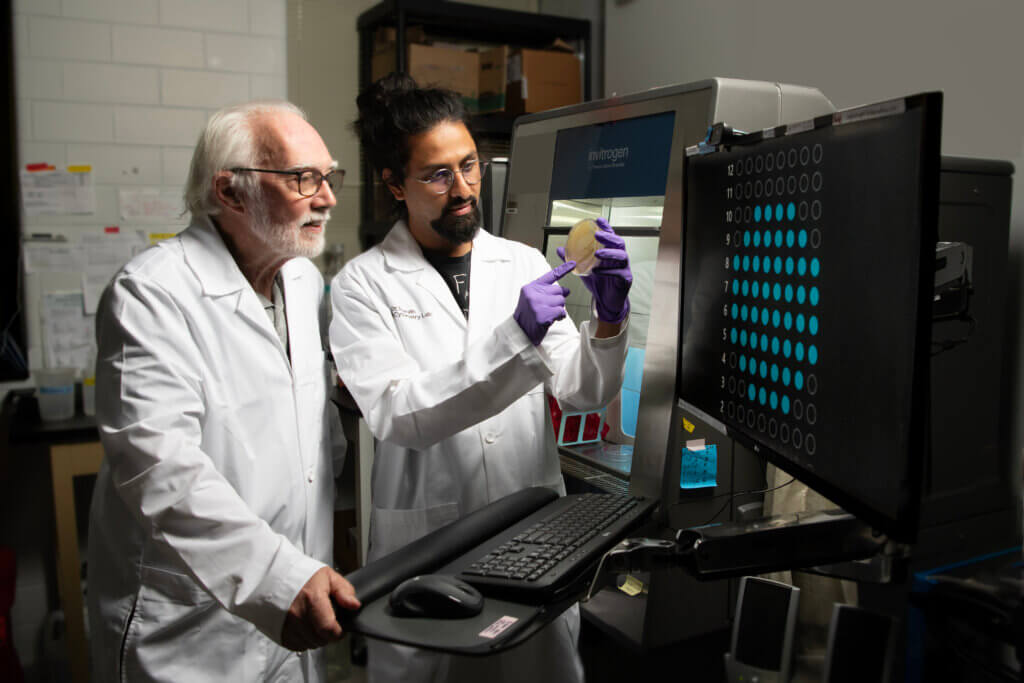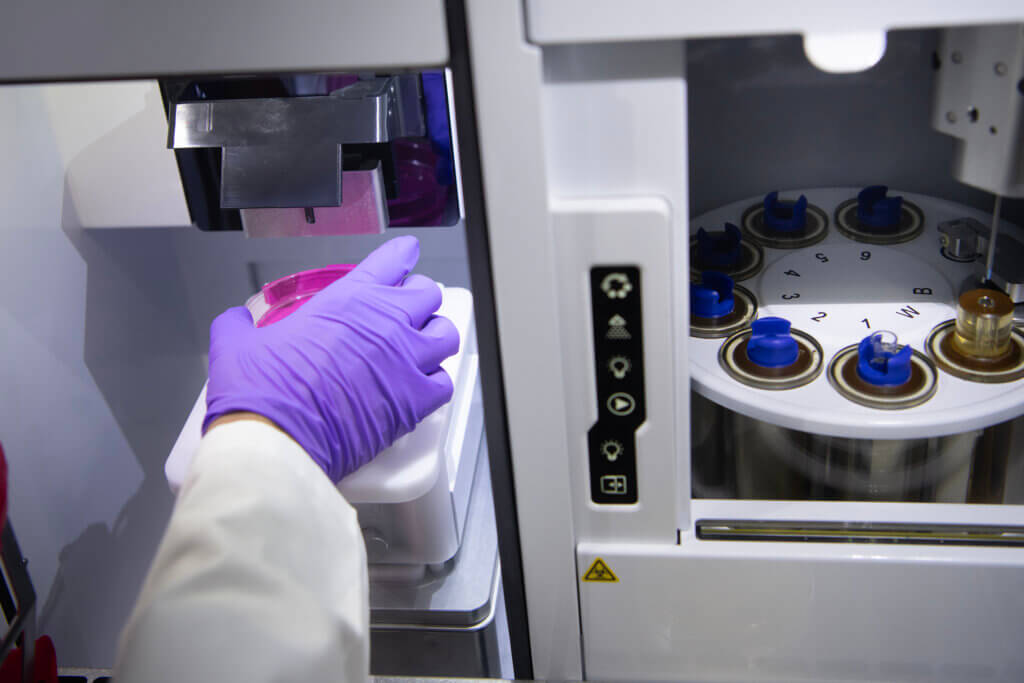
Years of growing resistance to antibiotics have sparked an urgent global health crisis, giving rise to challenging biological threats and the emergence of more dangerous viral, fungal and bacterial strains, commonly called superbugs. Compounding the threat is the difficulty in a quick diagnosis, complicating how to effectively treat these illnesses.
Purdue postdoctoral researcher Sharath Iyengar in the College of Veterinary Medicine’s Department of Basic Medical Sciences spends hours in the G221 laboratory at Lynn Hall, seeking answers to this health challenge. Key to Iyengar’s effort: advancing and expanding the use of flow cytometry in diagnosing antibiotic resistant, also called antimicrobial resistant (AMR), strains of bacterial infections. Defined as the ability of microorganisms to withstand antimicrobial treatment, AMR is responsible for millions of deaths annually.
“When you go to your doctor with an infection, doctors might take a culture and formally analyze it. Only then will the doctor know if this a resistant strain, but the process to analyze might take three to seven days,” Iyengar says. “Yet doctors believe the infection is too risky to wait to treat. So, they prescribe from a broad range of antibiotics that can be helpful for the majority of infections.”
Iyengar looks to change that process, or at least refine it, by helping doctors know much earlier the specific strain. In the case of a bacterial infection, he wants to equip doctors with a more expeditious and efficacious diagnosis process so they can prescribe the most effective medical formulation, the proper concentration and for how many days.
“We can’t neglect antimicrobial infections as a threat any longer,” Iyengar says. “We are building a database of images of the most common and dangerous strains of bacteria. We can compare the patient sample with what we have trained the software to match through our database of images. This match can happen in just five to 10 minutes. It’s automated in such a way that it can analyze while the colony is growing.
“My goal is to revolutionize diagnostic platforms and improve patient outcomes,” says Iyengar, who is the lead author on a recent research paper published in the journal Applied Microbiology and Biotechnology.
Urgency of an AMR response
Iyengar’s research, funded by a U.S. Department of Agriculture grant, is extremely timely.
- Global health care leaders came together at the World AMR Congress in September, where they cited AMR as “one of the clear and present threats of our time, and if left unchecked could have dire consequences.” Antibiotic-resistant infections in 2019, the organization says, played a role in 5 million deaths worldwide, and AMR threatens to kill a projected 10 million by 2050, highlighting the burden of the current superbug crisis.
- Another study published in mid-September in the journal The Lancet said that cumulatively, from 2025 to 2050, the world could see 39 million deaths attributable to AMR. Researchers in the study, led by the Global Research on Antimicrobial Resistance Project, forecast that South Asia, Latin America and the Caribbean will have the highest AMR mortality rates by 2050.
- Globally, the World Health Organization lists AMR among the top 10 global health challenges while calling for urgent multilateral actions. Meanwhile, biotech and pharmaceutical companies are pointing to the Pioneering Antimicrobial Subscriptions to End Upsurging Resistance (PASTEUR) Act, a bipartisan bill before Congress that, among other things, would help spark an industry resurgence in research and development to address the threat of AMRs.
Since the onset of a penicillin-resistant Staphylococcus in 1940, resistance to a range of antibiotics has been reported for MRSA, erythromycin-resistant Streptococcus, gentamicin-resistant Enterococcus, carbapenem-resistant Enterobacteriaceae, cephalosporin-resistant staphylococcus and others.
The most common and dangerous antibiotic-resistant bacteria listed by the WHO includes carbapenem-resistant Enterobacteriaceae such as Escherichia coli and Klebsiella as well as MRSA and antibiotic-resistant mycobacterium tuberculosis strains. Known as a dangerous bacterial strain, MRSA can cause skin infections. When introduced into the body, however, it can instigate bacteremia, pneumonia or infection at surgical sites and is responsible for up to 80% of hospital-associated infections globally.
A passionate researcher with a PhD in biotechnology, Iyengar has eight years of lab research experience and another three years working in the world of computer software.
His goal is to develop point-of-care technologies and improve diagnostic platforms for detecting pathogenic bacteria and cancer cells to more quickly and accurately diagnose bacterial infections and even major diseases like leukemia. His diagnostic tools: technologies ranging from microfluidics and spectral and multicolor spectral flow cytometry processes to microscopy, elastic-light-scattering technologies, and machine learning, among others.
“The use of flow cytometry in microbiology has been limited, though. This is because of the inadequate availability of bacterial-specific stains as well as expensive, antibody-based fluorophores, ineffective stain cell permeability and challenges in distinguishing bacterial cells from cell debris due to their similarity and their small size,” Iyengar says.
“Additionally, staining cells demands multiple washing steps, which limits the sensitivity of detection because of cell volume. Further, most flow cytometers are not equipped to handle pathogenic organisms.”
Charting a global path to Purdue
Iyengar is the epitome of Purdue’s global draw. A native of India, he earned a bachelor’s, master’s and doctoral degrees from universities in Germany and Sweden.
Through faculty advisor Aman Russom, a professor of nanobiotechnology at Sweden’s KTH Royal Institute of Technology in Stockholm, Iyengar was introduced to Purdue Distinguished Professor of Cytometry J. Paul Robinson. After he presented his PhD work to Robinson, who had worked with Russom on research efforts in Africa, Iyengar was lured to Purdue as a postdoctoral researcher, where he has spent the past 2½ years.

“Sharath has an amazing ability to dig deeply into the problems he is trying to solve in his research,” says Robinson, who holds a joint appointment in the Department of Basic Medical Sciences and the Weldon School of Biomedical Engineering and serves as director of the Purdue University Cytometry Laboratories. “He pays attention to the details and focuses on the current scientific knowledge and where the gaps are. He has advanced his knowledge base by integrating high-technology tools such as spectral cell sorting and very advanced classification methods that are critical when solving high-parameter problems.”
Mentors such as Russom, Robinson and others have been essential to Iyengar’s academic success and research efforts before and during his time at Purdue. He appreciates their investment and time in his academic pursuits while also allowing him to work independently.
“All my mentors have been very kind and respectful of the time to work and to work through different problems. My mentors have played a very important role in my academic journey,” he says. “Anyone can perform the protocol, but for these kinds of challenges that are not available in research papers or the marketplace, you have to come up with solutions. My mentors have always been there to help me, to guide me, to give feedback. But at the same time, at the end of the day, you have to do the work.”
